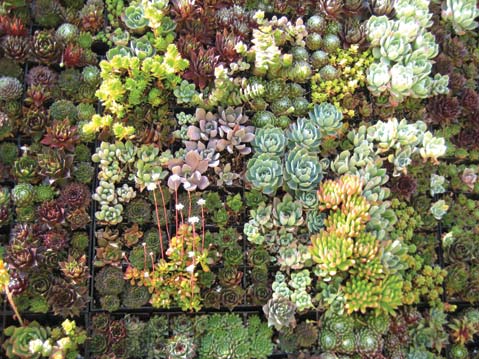Savvy Succulent
An Adaptation that Allows Plants to Survive in an Adverse Environment

Succulence — what the heck does that really mean? Well, the dictionary more or less equates it with “juiciness” or the quality of being “juicy.” So a pork sandwich that is described as succulent means that it should be nice and juicy. In the plant world, it really refers to a particular set of adaptations to adverse environmental influences that plants must possess to survive. Succulent plants store water within the cells of their leaves and/or stems, and/or roots, to survive through extended periods of minimal or nonexistent rainfall.
One of the great wonders of the flora of earth is that many different plants have independently survived the millennia by evolving very similar strategies to thrive in particular ecosystems. Aquatic plants actually have to repel water to protect their internal processes, conifers that live in frigid northern climes and high elevations have what amounts to antifreeze in their veins, and many species can survive the high temperatures and lack of rainfall that characterize deserts worldwide with a variety of physical modifications.
One of those adaptations, succulence, happens to be a fine way to survive desiccation such as could be experienced in desert habitats. What many may not realize is that it has very little to do with the actual genetic makeup of the species. This is a case of nurture dictating what nature does not. There are succulent plants in myriad families, perhaps the majority of them. These species have evolved to maximize water storage (and also minimize water loss, but that is another story). Extra space within leaves, stems, and roots is given to large cells that don’t do much except act as reservoirs of water. When rain is plentiful, the plant takes up water and stuffs it into these tanks as quickly as possible. It can be dosed out over time later, to fulfill all the rest of the plant’s functions (almost nothing happens in a plant that does not require water or at least a wet environment).
There are some plant families in which the majority of members are succulent. These include the crassula family with members such as Sedum (like the jelly bean plant), Echeveria (hens and chicks), and of course Crassula (jade plant is the most commonly known one). Most of the aloes, cacti, and many euphorbias are also succulent in nature. But it might surprise some to know that there are succulent oxalis (sourgrass and other species are common weeds), cucumber relatives with succulent leaves or swollen stems to store water, and quite a few succulents that are kin to the milkweeds that monarch butterflies rely on. There are succulent species in the sunflower family such as chalk sticks (Senecio mandraliscae) and cousins of table grapes that are drought-adapted like Cyphostemma (sometimes called wild grape in its native Africa).
For gardeners and landscapers, the multitude of plants that can withstand dry periods can be a great boon. Succulent plants come in all manner of sizes, shapes, and colors. Nurseries are jumping on board the succulent plant bandwagon, and the diversity available is growing every year. New books appear on the subject with increasing frequency, as well, so beginners have plenty of resources to tap for information about growing these adaptable garden subjects.
November Tips
• Sow wildflower seeds now, and if the rains don’t come often, keep watered until established.
• Get your pruning shears, loppers, and saws in shape for the upcoming winter pruning season. Sharpen blades and tighten screws. Sharp blades make clean cuts with less potential damage to plants.
• Comb out dead leaves of evergreen grasses such as deer grass (Muhlenbergia rigens), and cut others like Miscanthus and Pennisetum to the ground when flower heads are done.
• There is still time to plant fall vegetables like carrots, beets, chard, and cabbage relatives from seed, especially since the soil is cooling so slowly this year due to all the warm fall weather.



